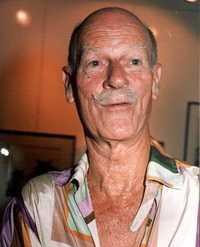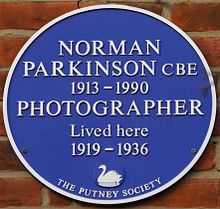Norman Parkinson


Norman Parkinson, CBE (21 April 1913 – 15 February 1990) was a celebrated English portrait and fashion photographer.
Biography
Parkinson (birth name Ronald William Parkinson Smith) was born in London, and educated at Westminster School.[1] He began his career in 1931 as an apprentice to the court photographers, Speaight and Sons Ltd. In 1934 he opened his own studio together with Norman Kibblewhite, in London's Piccadilly.[1] From 1935 to 1940 he worked for Harper's Bazaar and Bystander magazines. During the Second World War he served as a reconnaissance photographer over France for the Royal Air Force.[2] In 1947 he married the actress and model Wenda Rogerson. From 1945 to 1960 he was employed as a portrait and fashion photographer for Vogue.[2] From 1960 to 1964 he was an Associate Contributing Editor of Queen magazine. In 1963 he moved to Tobago, although frequently returned to London, and from 1964 until his death he worked as a freelance photographer.[1] He was made a Commander of the Order of the British Empire in the 1981 New Year Honours.[3]
Photography
Parkinson always maintained he was a craftsman and not an artist. From his early days as a photographer up to his death he remained one of the foremost British portrait and fashion photographers. His work, following the lead of Martin Munkacsi at Harper's Bazaar, revolutionised the world of British fashion photography in the '40s by bringing his models from the rigid studio environment into a far more dynamic outdoor setting. Humour played a central role in many of his photographs which often included himself. As well as magazine work he also created celebrated calendars featuring glamorous young women. When royal photographer, Cecil Beaton, died in 1975, Parkinson took over.[4] Notable portraits included Princess Anne in 1971 and Queen Elizabeth The Queen Mother in 1980.[5] In 1981, he was awarded the Royal Photographic Society's Progress Medal, which "carries with it an Honorary Fellowship of The Society"[6] and later the Lifetime Achievement Award of the American Society of Magazine Photographers.[1] He received a Google Doodle on 21 April 2013, in honour of his work.
Discoveries
- He spotted Nena von Schlebrügge, the mother of Uma Thurman at age 16 when she left her senior school in Stockholm, and brought her to London to model for Vogue magazine.
- His photo of Jerry Hall sparked Bryan Ferry's interest to invite her over to star as the cover model for Roxy Music's fifth studio album, Siren.
- He also discovered model Celia Hammond for the magazine Queen in 1959.
Publications
- Sisters under the skin (1978, St. Martin's Press, ISBN 0-312-72746-1)
- Norman Parkinson: Fifty Years Of Style And Fashion (1984), The Vendome Press, ISBN 0-86565-031-4)
- Would you let your daughter? (1987), Weidenfeld and Nicolson, ISBN 0-297-78683-0)
- Norman Parkinson (1987, Hamilton Galleries, ASIN: B0007BRZFA)
- Norman Parkinson: Portraits in Fashion (2004, Trafalgar Square Publishing, ISBN 1-57076-277-5)
- Norman Parkinson: A Very British Glamour by Louise Baring, (2009, Rizzoli) ISBN 978-0-8478-3342-9 – a tie-in with the exhibition of the same name at Somerset House, 9 October 2009 — 31 January 2010
Notes and references
- Notes
- References
- "Progress Medal". Royal Photographic Society. 1981. Retrieved 19 April 2013.
- "New Year Honours". The Times (60814) (London: NI Group). 31 December 1980. p. 6.
- "Obituaries: Norman Parkinson". The Times (63631) (London: NI Group). 16 February 1990. p. 14.
- McFadden, Robert D. (17 February 1990). "Norman Parkinson, Photographer, Adventurer and Royal Gadfly". New York Times (New York: The New York Times Company).
- Baring, Louise (10 October 2009). "Norman Parkinson: Never out of fashion". The Daily Telegraph (London: Telegraph Media Group). Retrieved 21 April 2013.
- "Norman Parkinson: legend behind a lens". Financial Times (London: Pearson PLC). 29 March 2013. Retrieved 21 April 2013.
External links
- The Norman Parkinson Archive
- National Portrait Gallery
- Norman Parkinson's portfolio (107 photos)
- Atlantic Review review of a recent retrospective book
|